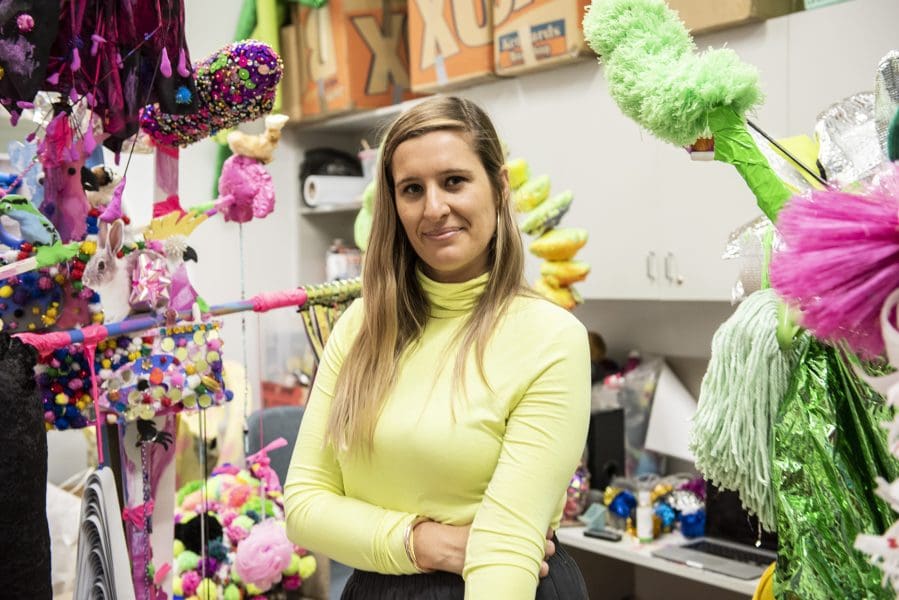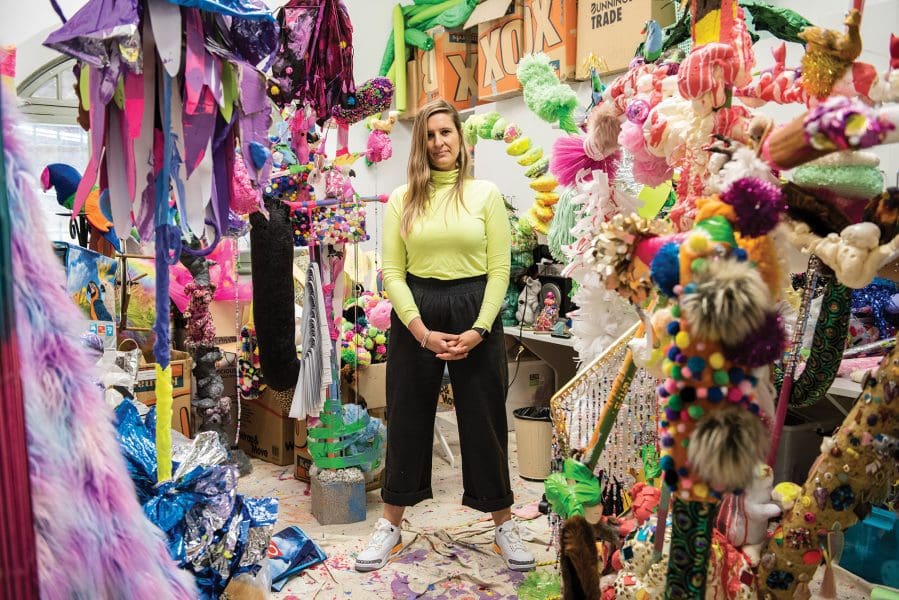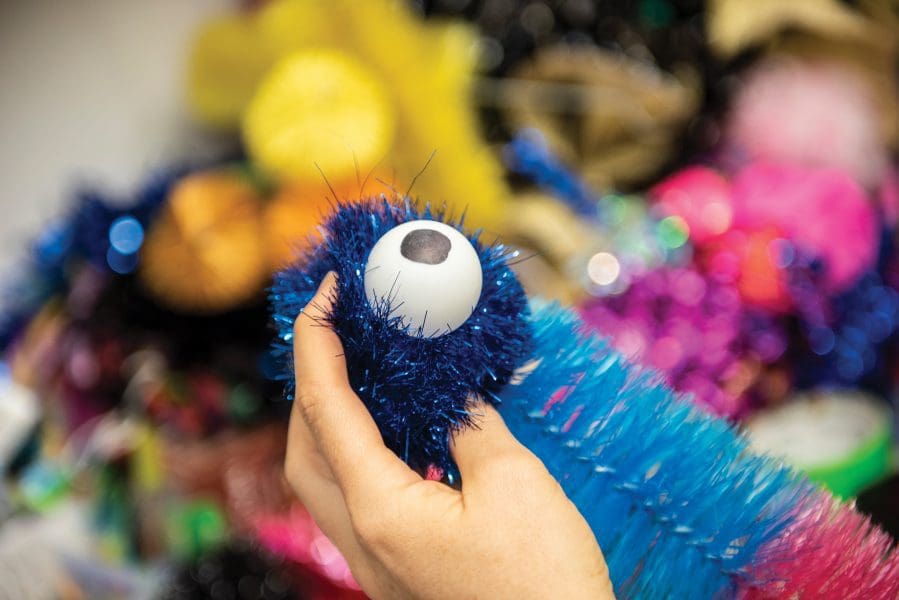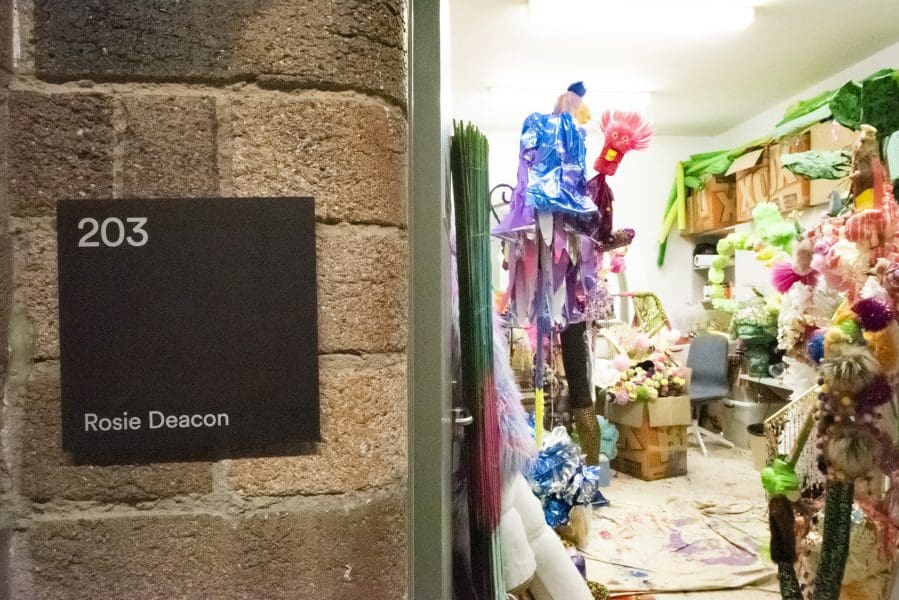
Piercing the veil
A new exhibition at Buxton Contemporary finds a rich complexity in the shadowy terrain between life and death.

Photographs by Hamish Ta-Mé for Art Guide Australia.

Photographs by Hamish Ta-Mé for Art Guide Australia.

Photographs by Hamish Ta-Mé for Art Guide Australia.

Photographs by Hamish Ta-Mé for Art Guide Australia.

Photographs by Hamish Ta-Mé for Art Guide Australia.

Photographs by Hamish Ta-Mé for Art Guide Australia.
Rosie Deacon started winning awards while she was still at art school. Since graduating in 2010 she has become known both nationally and internationally for her immersive, often interactive, installations. Or as Deacon herself puts it, “I feel like I’ve totally lucked out since I finished uni; I can just make all these big wild things.” Big and wild may be accurate, but it’s also something of an understatement. Deacon creates wonderfully excessive and playfully exuberant environments populated by kitschy-cool creatures spawned from both a fascination with Australiana and a deep love of Australian fauna.
Tracey Clement met the artist at her studio in the Powerhouse Museum in inner city Sydney, and Deacon explained that her work is inspired by both her country childhood and her current city home.
PLACE: I was raised in a regional area, but I came to Sydney to study and kind of never left. The country is far too quiet for me now. I love going back for breaks—just being peaceful in nature—and I love all the animals, but I find it too slow. And even though my work is very much based on my upbringing in the country— maxed-out and glammed-up—I think I really get most of my inspiration from the city; the really bright colours and the razzle-dazzle of the lights and everything that’s happening.
I’ve had a studio here at the Powerhouse Museum since late 2019. I was invited initially to do a three-month summer residency, running workshops based on the Jenny Kee and Linda Jackson: Step into Paradise exhibition. And then they opened up the studios for 12 or 18 month residencies.
My 18 months expires on my birthday, halfway through 2021, and I’ll reapply. I’m hoping to stay on for another year; it’s such a great space right in amongst the energy of the city.

PROCESS: The pace of the city, with everything moving, suits me. I’m a very fast-paced worker; I make rapidly and I’m sort of impatient sometimes. I’ll just use a glue-gun to stick things together rather than using a drill or nails.
I go in to the studio most days of the week; I don’t really have days off. I find I go through big energy stages where I’m just pushing it and work, work, work, and then after a big show or something I’ll often feel very strange and bizarre and empty. But even then I usually push myself to at least do something; something just repetitive and calm like making pompoms.
My work involves a lot of repetitive making, and I do almost all of it myself. I actually really enjoy doing handcrafting. And it would have a different feeling if I outsourced the labour. There’s something really warm—like a nice sort of comforting feeling—knowing that I’ve made it all. The work would look different, and feel different, if I didn’t.
My work is never really done until it’s installed; nothing is really totally finished beforehand. Like with my show How do I know if my parrot is happy? at The Lock-Up in Newcastle, I have a two-week install. So I’ll arrive with lots of stuff and I’ll build it up there. That’s sort of when it all comes alive and makes sense. I do have a bit of a plan, but I like to keep room open for seeing what happens in the space. That seems like the most exciting part to me.

PROJECTS: The other project I’m working on right now is Koala Train, an immersive school holidays installation for the Powerhouse Museum transport hall. I was asked to respond to that gigantic space, and I’ve worked with the fantastic team here to build this massive cut-out of a train. It’s covered in pompoms and has a three-metre-high koala on top. And inside my new video work is screening. It’s an instructional dance video of me, in three different koala costumes I’ve made, performing moves inspired by 1980s YouTube aerobics championships and morning television [show] Aerobics Oz Style.
I’ve used koalas in my work since the very beginning. Some of it comes from things I’ve seen as a young kid growing up on farms: really feeling for animals and them being the most beautiful things you’ve ever seen, but also seeing them run over on the roads and being culled by kangaroo shooting.

And these contradictions left me with mixed feelings. Sometimes it’s like I have a big spinning sort of feeling in my body: hard to soft, angles and sharpness then really beautiful and cuddly and soft. And I think it sort of comes out in the work—how I really adore Australian wildlife, but I also make my animals strange and a bit ugly and weird as well.
And all the koalas also come from looking at kitsch Australiana objects and souvenirs. When we lived out in Nyngan, central NSW, we used to come on family holidays down to Manly beach in Sydney which was filled with souvenir shops. And I just remember being so surprised and amused. But also I didn’t like seeing rows and rows of stuffed koalas and kangaroo paw bottle openers. I remember being quite horrified, but also very interested.
I use a lot of different bright, shiny, sparkly and colourful materials; for me installation is going to the max in overdrive. So much of everything in life is so serious and stressful. I like making things that are so over-the-top and ridiculous that you might not exactly know what it is, but then you might find yourself just joining in a little bit and forgetting about daily life and just having fun.
How do I know if my parrot is happy?
Rosie Deacon
The Lock-Up
5 December 2020—31 January
Koala Train
Rosie Deacon
Powerhouse Museum
12 December 2020—31 January
This article was originally published in the January/February 2021 print edition of Art Guide Australia.